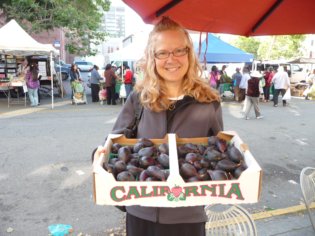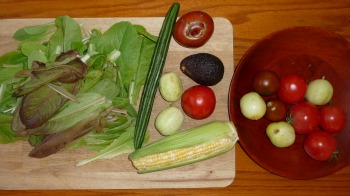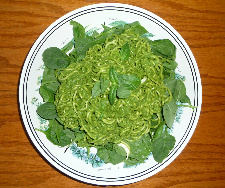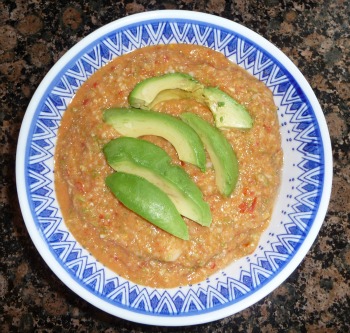| Back to Back Issues Page |
 |
|
Vibrant Living, Issue #133 Food Choices and the Environment - Easy Raw Food - Raw Recipes July 28, 2012 |
Greetings Health Seekers,Welcome to the VIBRANT LIVING NEWSLETTERThis time of year is so Wonderful. The variety of foods available makes it so nice and easy to enjoy the raw food way. In this issue of Vibrant Living I’ve written an article on the how to take advantage of this particular time of year to make the raw food diet easy, simple, and enjoyable. I’ve posted some staggering facts about diet choices and their impact on the environment. Our dietary choices are the one thing that most of us have complete control over and can shift the health of the planet in a heartbeat. But will it be a positive shift or one that adds to the burden of the planet and all life forms? There is also a short blurb about one of my favorite fruits…can you guess? Then there are the usual quotes and of course a few new Raw Food Recipes for your enjoyment. So Enjoy!
"Every patient carries her or his own doctor inside." ~Albert Schweitzer
*************************
What an Easy Time of Year to Be Raw I just love this time of year, the food is abundant and simple quick meals abound. On occasion I enjoy making a raw recipe, but quite frankly most of the time I just eat food out of hand. Oh, except for breakfast; I still rock a super green smoothie every morning unless I’m travelling. But I digress. For me, part of the appeal of the raw food lifestyle is its simplicity, and ease of preparation and clean-up. Call me lazy or whatever you like, but I just never have been a fan of long, time-consuming recipes that dirty every pan in the house and require more time to clean-up than it took to eat the meal. Most meals I eat are simple, quick to put together and require virtually no clean-up. Now that’s my idea of good living. My lunches are typically comprised of some type of fruit (fresh figs come to mind), with either cukes, celery, or greens depending on what is in season and looking good. Lunch is eaten out of hand, with virtually no clean-up! It couldn’t be simpler or tastier in my opinion. I choose fruit which is in season, fresh, ripe, and almost always organically grown unless I know the source and how it was grown. Dinner is just as easy for me. My favorite is to head up to the garden and eat greens fresh off the plant, followed by tomatoes and cukes. Usually I’ll eat an avocado at the end. Depending on what’s ripe in the garden and what I have a feeling for I may change it up a little. Sometimes I’ll enjoy a fresh ear of corn or two, and sometimes I’ll cut nori seaweed into strips and place it in my lettuce leaves. Sometimes fresh okra from the farmer’s market might catch my eye so I’ll enjoy that as well. Sometimes I eat right out of the garden, and sometimes I’ll pick and eat inside, but either way the clean-up is fast. I remember someone telling me one time, “if you have to scrub your pots and pans to get the food residue off, just think how hard that is on your digestive tract”. That makes so much sense. Even raw gourmet recipes cleanup pretty easily, but it can still be very time consuming preparing and cleaning up after. I’m always struck when people say “I tried the raw food diet, but it took so long to prepare meals”. I think what the heck. The raw diet couldn’t be simpler or easier. If I’m out and about and get hungry I can pull into a grocery and pick up a fresh snack pronto and be on my way again. As the seasons progress my food choices change so my palate never tires of what is available. It’s the cycle of life playing out in the food that I eat during the seasons of the year. Sometimes I do feel a certain craving for a food like cauliflower or cabbage and feel that my body must have a particular need for the nutrients available in that food so I follow my instincts and enjoy what is calling me. The picture shows what a typical dinner might look like. If you’ve not tried this style of simple eating I recommend you give it a try. Perhaps you won’t eat all your meals like this, but you may find you enjoy it on occasion and perhaps when your time is limited.
************************* "Fitness - If it came in a bottle, everybody would have a great body." ~Cher
Effects of Livestock Production • Animal agriculture produces 18 % of the world’s greenhouse gas emissions, compared with 14% from all forms of transportation combined. • Livestock also create other toxic gases, including nitrous oxide, methane, and ammonia. • Nitrous oxide has 296 times the global warming potential, and methane 23 times, of CO2. • Ammonia contributes to acid rain and ecosystem acidification. • Livestock are the identified culprit in 15 out of 24 important ecosystems that are reported to be in decline. Land Damage • Grazing livestock occupy the equivalent of 26% of the ice-free terrestrial surface of the planet, and one-third of all arable land is used in producing food for these animals. • Forest clearing for new pastureland is a major source of deforestation. In Latin America, 70% of former Amazon rainforests has been given over to grazing. As the “lungs of the Earth” these forests are vital to removing greenhouse gases from the atmosphere. Water Damage • The livestock industry is one of the heaviest users of our scarce water supply, and contributes to excessive growth of organisms in water, oxygen depletion of water, and the erosion of coral reefs. • Livestock pollute our waters with their waste, antibiotics, hormones, chemicals from tanneries, fertilizers, and pesticides used to spray the feed crops they consume. • US livestock are responsible for 55% of soil erosion and sediment, 37% of pesticides, 50% of antibiotics, and one-third of the nitrogen and phosphorus polluting our fresh water sources. Species Lost • The presence of livestock over vast land areas, coupled with their depletion of food crops, contributes to the loss of other plants and animals that are unable to compete.
If you’ve ever been around a working farm, even a small one you can see how much effect it has on the environment. Years ago I lived in an area of the northwest that had a huge dairy industry that spread from one end of a large valley to the other. The valley was home to multiple rivers, streams and creeks which would overflow their banks every rainy reason washing tons of pollutants from the livestock out to the ocean. Once in the ocean these contaminants become part of the cycle of life, or death in this instance; as sea creatures, plants, and coral reefs become negatively affected. As the ocean continues its decline so do the many forms of wildlife that depend on the waterways for their survival. We as land dwellers depend on a healthy ocean to help support life for us in so many ways. For one, our rain waters come from the oceans of the world. Without a healthy ocean life on land cannot survive long. Although I am vegan I don’t feel it’s my place to tell others how they should eat, and what choices they should make. That I think is a decision that everyone needs to make for themselves. My purpose posting these stats is to show what some of our dietary choices can lead to and stimulate thought and conversation. Every time I’m accosted by one of those well meaning young people with a petition at the grocery store about saving the planet I ask them what they ate today and what they will eat later. Sadly most of the time they are not even aware that dietary choices could have a huge impact on our planet. I tell them I’ll be glad to chat when they’re vegan. We must all be the change we wish to see in the world. One reason to be so concerned with meat and dairy consumption is that on the global level it is on the rise as third world countries emerge and develop a middle class. This new group of consumers looks to emulate the west in their consumption of animal products because for them, just like it is/was for us in the US, it’s a sign of affluence. Sadly though, as they follow our dietary model they begin to develop our diseases as well. But just think of the impact on our already compromised environment as millions upon millions around the world increase their consumption of meat and dairy. Think of the utter devastation. Surely we cannot survive such an onslaught. I’m not suggesting that everyone should give up their animal products altogether. I’m hoping that they will be mindful of the power of the fork and at least reduce their consumption of animal products. They will be rewarded in both better health and a cleaner environment. Now how can you beat that?
*******************
Figs, Gift of the Gods
Fresh figs are one of my favorite fruits and foods for that matter…lol. When they come into season I am in heaven…fig heaven. We have nine fig trees in the yard and a few more in pots on the deck. Although the trees are still small they do provide some fruit for our enjoyment, just enough to make you want to go out and plant some more trees. And speaking of such, fig trees are exceptionally easy to grow so if you have a sunny patch somewhere in your yard you may want to give it a whirl. If you have a friend with a tree or see one in your neighborhood you can ask for a cutting during the winter months when the tree is dormant. Any branch or cutting will do. Cut off a branch and plant it in the soil at least a foot for a strong root system. Fig trees are also available at the farmer’s market and of course your local nursery.
Fig trees like well-draining soil, but will grow just about anywhere. In fact I have seen them do quite well in somewhat wet ground near creeks where they get a constant source of water and can grow quite fast. So like I say, plant your fig(s) anywhere they get sun. They may not fruit the first couple of years, but they grow relatively fast and should be producing by the third year or so.
 For us in northern California, late June is the first part of the season and runs for just a few weeks. Then in early August comes the second part of the season, which can run for several months. The figs from the first crop are usually larger fruit than the later crop, but they all taste great. As with all fruit, figs are best fresh off the tree, but you can get pretty fresh figs at your farmer’s market. The ones in the stores tend to be picked rather prematurely and so are not always the tastiest, yet are the most expensive. Go figure! When picking your own, again like most fruit, the ripe ones will come off easily in your hand with a slight twist.
For us in northern California, late June is the first part of the season and runs for just a few weeks. Then in early August comes the second part of the season, which can run for several months. The figs from the first crop are usually larger fruit than the later crop, but they all taste great. As with all fruit, figs are best fresh off the tree, but you can get pretty fresh figs at your farmer’s market. The ones in the stores tend to be picked rather prematurely and so are not always the tastiest, yet are the most expensive. Go figure! When picking your own, again like most fruit, the ripe ones will come off easily in your hand with a slight twist.
You may find a fig tree in your neighborhood that the owners either can’t keep up with or are not eating at all. This is a great opportunity to introduce yourself and see if they will allow you to pick some figs so they don’t fall and rot on the ground bringing rodents and such around their property. Hey, neighbors helping neighbors, that’s what it’s all about. Offer to pick some for them when you pick for yourself to sweeten the offer a little.
Fresh figs are relatively low in calories with 100 grams (a little less than a quarter pound) having just 74 calories. When figs are dried they become calorically dense and 100 grams now equates to about 250 calories. They are highly alkaline, highly mineralized, and high in calcium, potassium, B1, B5, B6, beta carotene, calcium, copper, manganese and iron. Because figs are high in fiber they are a great laxative and intestinal cleanser. During fig season I may eat three or even four baskets in a day. If you are not used to eating figs or foods similar in fiber content you may have to watch your consumption at first or you may be visiting the bathroom more than you would like. Figs go great in a smoothie with oranges and greens, or eaten right out of hand. One of my favorite lunches is figs and cucumbers. Simple and so satisfying. A nice green salad can be super charged by tossing in figs halves or quarters, or perhaps a spinach salad with figs and walnuts. The second part of the season is just about to begin so my recommendation is to get out and enjoy this gift from the Gods while they’re here. And perhaps I’ll see you under the fig tree.
********************************
"If you trust Google more than your doctor then maybe it's time to switch doctors." ~Jadelr and Christina Cordova
Although I believe strongly in a diet comprised mostly of fresh raw foods, I do supplement with super green powders, nuts, seeds, sea vegetables, and the occasional dried fruit such as goji berries. If you’re like me you’re always looking for a good deal on quality food whether it’s fresh from the farmers market or purchased online, so I thought I would share with you where I make most of my online purchases. You may already be aware of the Raw Food World and their “at cost” specials, but if not here you go. When you go to purchase supportive foods like those listed above you can save money and get “at cost” special pricing by going to the link below and clicking on the “at cost” specials tab. This also allows you to save up to 14% on every order of their already good deals. The important thing to remember is that fresh is best and these products are supportive and should not be your mainstay. Enjoy! ************************************
There are a number of new testimonies at the website which I hope you will read and pass on to others when you feel they would benefit. And please feel free to leave your own story if you feel moved to do so. You need not be 100% raw to share a testimony; the fact is most people on the raw diet are not 100% anyway. Your story may inspire someone else, perhaps from the other side of the globe, to give the raw food diet a try.
Success stories.
Please send me your health questions, they can be submitted anonymously if you prefer, and you may help someone else improve their health and quality life.
Your questions.
Be Well and Wonderful, Hugh
*****************
hugh@raw-foods-diet-center.com MEDICAL DISCLAIMER The contents of my website and my newsletter are gleaned from my experiences and observations, meant only for educational purposes and not intended to replace medical advice, consultations, or treatment of any kind. I recommend you see your professional health care provider if you suspect you have an illness or disease of any kind. I'm not medically trained, and I would never suggest or imply that I know what is best for someone else's body or overall health, ultimately each of us is the only one who knows what's best for us. |
| Back to Back Issues Page |


